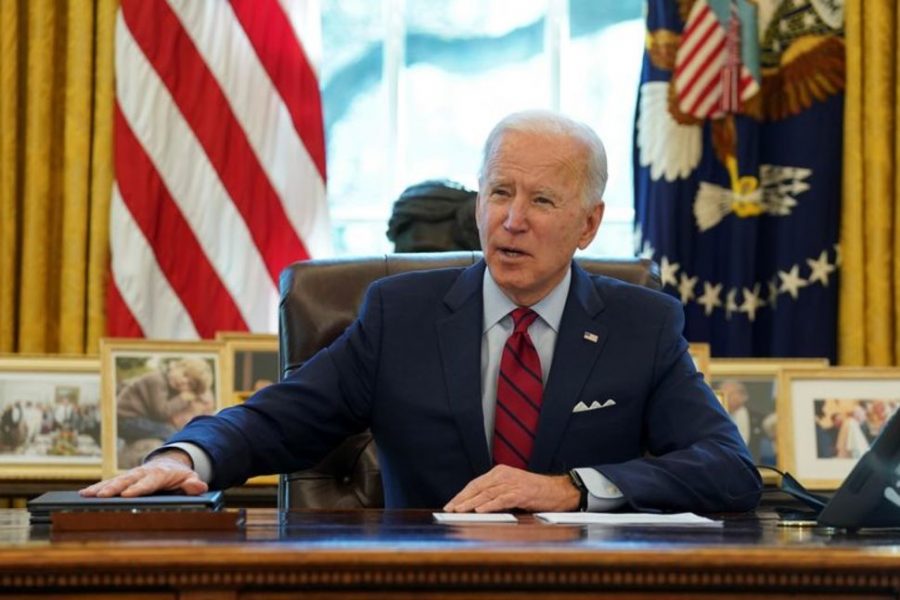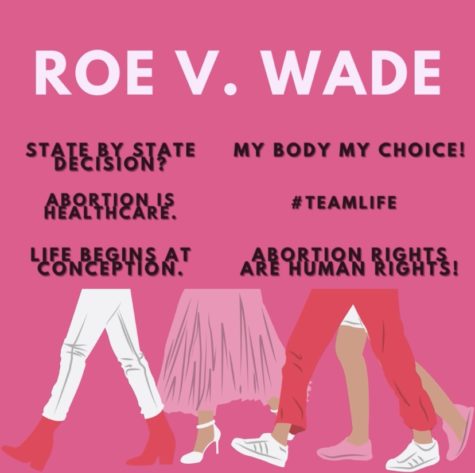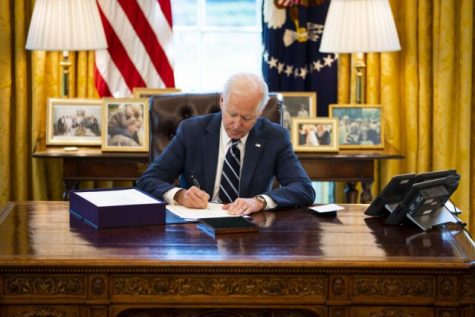Biden Rolls Out Dozens of Executive Orders In The Month of January
High School Students Trey A. and Sarah T. give their thoughts
President Biden speaks before signing executive order on healthcare, January 28, 2021
The dust has settled- the electoral war between the GOP outsider and the old guard Democrat has finished with the latter on top. Despite claims of fraud, a legal war waged by Trump’s team of wars, and a riot at the Capital that claimed the lives of five people, the Biden administration entered the White House on January 20.
In his first month Biden has so far signed dozens of executive orders which has shifted America’s trajectory from conservative control to a more liberal attitude in policy. Throughout his presidency it is thought that the executive orders will become rarer and less impactful, but one must know what an executive order is to grasp the full scope of the power of the executive branch.
An executive order is an issuing of an order that manages the operations of the federal government. There is no minimum or maximum amount of executive orders a president needs to or can sign. These executive orders stay in place until they are reversed by another executive order, found to be unlawful, or expire on their own terms. Every president, with the exception of William Henry Harrison, has issued what can be described as executive orders. Famous examples of executive orders are FDR’s Executive Order 9066 which relocated all Japanese-Americans on the West Coast to government run prison camps, and Lincoln’s Emancipation Proclamation.
A good case to show the extent of executive orders is the case of Harry Truman’s Executive Order 10340. This order placed all the nation’s steel mills under federal control, but was found invalid by the Supreme Court in Youngstown Sheet & Tube Co. v. Sawyer because the directive attempted to make a law, rather than clarify or enforce a law laid out by Congress of the Constitution.
The executive orders Biden has issued so far seem to be safe from being deemed invalid. They may seem small because we haven’t personally been affected, but research into them shows that these directives push America into a progressive direction. Such a direction is more in line with policies pushed by the Democratic party such as raising wages, handling the climate crisis, and pushing for social policies to achieve a more equal society. So what are these orders?
On his first day in office the President signed the most amount executive orders yet in his administration, most likely to the most he will do in a day his entire term. Such a large amount at the beginning is due to the fact current president’s want right what they see as wrong created by the previous administrations, as well as pushing for their objectives as quickly as possible. These executive orders are:
- Rejoining the Paris Climate agreement- a foreshadowing of future legislation the democratic party may pass in regards to climate change.
- Executive order to promote racial equity
- Ending Trump’s ban on migration from seven Muslim majority countries- this order though does not permit the same migration policy that was present before the ban because of the pandemic. It’s likely though once COVID is cleared the same policy held before the ban will be brought back.
- An executive order requiring masks to be worn on federal property
- An executive order creating the position of COVID-19 organizer to help create a more efficient pandemic response and vaccine distribution
- An executive order that undid restrictions on federal agencies on making regulations
- An executive order that includes undocumented immigrants in the Census after Trump’s 2020 attempt to exclude them
- Biden signed an executive order that cancelled the Keystone XL pipeline and paused oil and gas leasing in the Arctic National Wildlife Refuge.
- Biden signed an executive order extending federal protections of nondiscrimination for the LGBTQ+ community
- Biden signed an order that mandated government employees to take an ethics pledge- this pledge restricts employees from receiving gifts from registered lobbyists, and bars them from becoming lobbyists two years after leaving their post.
- An order pausing federal student loan payments
On his second day in office Biden signed more executive orders. These orders include:
- Reversing Trump’s immigration enforcement policies- this pattern is likely to indicate a more humane and softer response on immigration than Trump’s hardline response
- An executive order that mandated mask-wearing on public transportation
- An executive order expanding access to COVID-19 treatments for critical care and long-term care facilities such as nursing homes
- Biden signed an order mandating all agency heads to gather data on COVID-19 so that the public may have a better understanding of what is going on. This signifies an era of COVID denialists like Trump who lied about COVID-19 and the data surrounding it.
- An executive order meant to strengthen the public health supply chain as well as developing a strategy for manufacturing supplies needed for potential future pandemics
- In an order representing many of his progressive social values, Biden signed an executive order establishing the COVID-19 Health Equity Task Force. This task force was created to make sure marginalized people are not left out of COVID recovery.
- An executive order to help continue and further give more support for schools to reopen in a safe way
- An executive order directing the Department of Labor to revise and issue new guidelines for employers to follow to maintain safety for workers during the pandemic
- Biden created a pandemic testing board that will coordinate the promotion and distribution of tests for COVID-19 though an executive order
The trend of multiple daily executive orders continued on Biden’s third day of being the president:
- An executive order expanding food assistance programs
- An executive order assisting veterans with debt
- An executive order that guarantees unemployment insurance for those who refuse to work due to the health threat of COVID-19
- An executive order that establishes a chain of “benefit delivery teams” that will coordinate the distribution of federal and state aid
- An executive order to deliver stimulus payments faster
- An executive orders that tells agencies to see what they can do within their authority to help amid the pandemic
- Biden signed an executive order that rolls back Trump-era policies that took away protections for federal employees and contractors. This executive order specifically contains a recommendation to the Department of Labor to raise the minimum wage of federal workers to fifteen dollars an hour, and it also reinstates the ability for federal workers to collectively bargain.
After pushing forward no new executive orders for a couple of days Biden signed three more orders.
- Biden reversed the transgender military ban which barred transpeople from joining the military. – This is one of the many policies the President is likely to push and will pave the way for the expansion of trans rights.
- An executive order reinstating travel restrictions for people coming from the Schengen Area (Western, Southern, and Northern Europe), the UK, Ireland, and South Africa.
- An executive order that strengthens the ‘Buy American’ policy. – A policy whose goal is to enforce the federal government only buys from American companies
Biden’s seventh day:
- The President signed an executive order that acknowledges a rise in discrimination against those of Asian descent, and directs the Department of Health and Human Services and the Department of Justice to best prevent discrimination, harassment, and hate crimes.
- An executive order that recommits federal agencies to engage in “regular” and “meaningful consultation with Tribal governments.”
- An executive order that directs the attorney general not to renew contracts with private prisons. – This is a step towards Biden’s attempt to better the criminal justice system. Private prisons have long been scorned due to their incentive to have as many prisoners as possible with little reforming.
- An executive order that directs the Department of Housing and Urban Development to review Trump-era policies and to take steps necessary to make sure they comply with the Fair Housing Act.
On January 27, Biden’s eighth day, he signed another pack of three executive orders:
- An executive order putting the director of the Office of Science and Technology Policy with ensuring scientific integrity over all federal agencies.
- An executive order reinstating the President’s Council of Advisors on Science and Technology
- An executive order designating climate change an essential element for foreing policy and national security along with the promise of naming a new emissions reduction target by late April.
Biden signed two last executive orders in January on the 28. These final executive orders of the month were:
- The rolling back of the “Mexico City Policy.”- This policy banned the US government from funding foreign nonprofits that promote or perform abortions. This action is a further commitment to his pro-choice stance.
- And last, but not least an executive order that reopens enrollment of healthcare.gov from February 15 to May 15 and directs federal agencies to investigate policies that reduce access to or undermine availability to the Affordable Care Act (aka Obamacare).
These executive orders have not gone unexamined though. I was given the chance to ask Latrobe conservative Trey Anderson and local liberal , both of which are our fellow students, on what they’ve heard and they’re thoughts.
Me: Have you heard about any of Biden’s executive orders during his time in office so far? If so, which ones?
Trey: I have heard about the pipeline and the mask mandate.
Me: What are your thoughts on both of these orders?
Trey: I don’t have an issue with it [the mask one], but with the pipeline I feel it may cause the loss of jobs and gas price increases
Me: When examining his legislation so far would you say you have a good feeling about a Biden presidency, or do you worry for the future?
Trey: He hasn’t been in office that long. I doubt his ability to lead the military, and I feel such a drastic increase in minimum wage would be harmful to small businesses
Trey is a supporter of the former President Donald Trump and who, despite not being able to vote, defended the man from what he thought was unjust criticism. As Biden’s administration pushes forth it is likely that in the crowd of critics in our small town Trey Anderson will likely be one of the many people defending their social and economic conservative beliefs.
Sarah Thomson on the other hand is on the complete opposite side of Trey in the overton window. To avoid any bias I asked her the same set of questions.
Me: Have you heard about any of Biden’s executive orders during his time in office so far? If so, which ones
Sarah: I have heard of the pipeline executive order, rejoining the paris climate agreement, rejoining the WHO, and pausing student loan payments
Me: What are your thoughts on these executive orders?
Sarah: It looks like all the pressure to push him to do something productive on his first day has worked, but I don’t want to keep my hopes high.
Me: When examining his legislation so far would you say you have a good feeling about a Biden presidency, or do you worry for the future?
Sarah: Seeing that there are already new environmental protections in place I am given hope in that avenue, but I feel way more could be done on student loan debt.
Sarah Thomson is a progressive who cares deeply about the environment and retains social and economic progressive beliefs. It is likely that during a Biden administration she’ll applaud a decent bit of Biden’s work, but will continue to advocate for her beliefs that he does not share.
These two students interviewed are great examples of advocacy and politicization generation z has been a part of; largely due to the populist crusades of Trump on the right and Bernie and the squad taking the internet by storm. This is no surprise considering gen z is the most online generation yet. It is likely that many young people will become apolitical simply due to the fact of Biden’s seemingly status quo administration, but the polarization caused by the former president will not go back into the bottle; thus giving the government future criticism coming both from a youth left and right.

James Miller is an eighteen year old Greater Latrobe High School Senior. James likes to read and hangout with his friends. He has a passion for politics...







